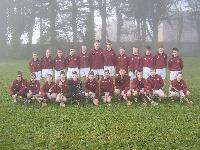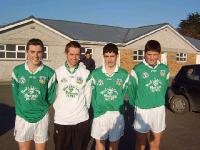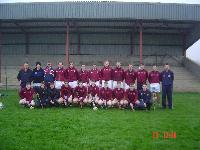Mr Redmond Jennings from St John’s Central College of Further Education Cork will visit the school on Tuesday 6th December to speak with Leaving Certificate Applied, Transistion Year and Leaving Certificate students about Post Leaving Certificate courses available to them at the college
Author: Hazelwood College
Holiday on Ice

The Leaving Certificate Applied 1 and 2 classes will be travelling to Limierkc’s Holiday on Ice to practice their Ice Skating abilities on Monday 12th December at 12.00pm
Fund Raising for Concern

A recent non-uniform day in the school raised €750.00 for the charity Concern. The day was organised by the Leaving Certificate Applied 2 class, who promoted the day and collected the money on the day from the students taking part in the day.
First Year County Semi Final Winners
Hazelwood College County Players
Cura talk to Senior Students
Cura talk to Senior Students

Cura will be in the school on Monday 28th November to speak with the senior students in Leaving Certificate Applied 1 & 2, and also the Leaving Certificate 1 & 2 classes
Under 18 Hurling Semi Final
Hazelwood College Advance to County Final
Hazelwood College advanced to the Limerick VEC County Final after a narrow victory over Abbeyfeale. Hazelwood victory was sealed by their ability to score goals by Chris Morrissey in the first half and by Derry Mc Carthy in the second. Despite plenty of possession, Hazelwoods wide total and a gritty Abbeyfeale performance , the sides were level mid-way through the second half.. It was at that stage that Michael Boyce stepped up with an inspirational score and Hazelwood began to pull away and earn their place in the County Final. Best for Hazelwood were Michael Boyce, Kevin Murphy and Tim Flemming until he was injured.
Hazelwood team: J.Nix, K McGill, N. Irwin, G. O Gorman, T Flemming, K Murphy, J Hartnett, M Boyce, C Morrissey, S Hehir, M Whelan, B Sheehy, J O Sullivan, K Cunningham and D Mc Carthy.
Subs used: S Fitzgibbon, J Coughlan
Subs: H O Gorman, C Lordan, J Ryan, CJ Fitzpatrick, D Stokes, G Keane and J Cotter.
Click on image to enlarge
Debating
On Thursday 24th November the school debating team will take part in Co. Limerick VEC Schools Debates in Rathkeale. At the same time another round of the debates will be taking place in the school at 8p.m.
Rathfredagh Cheshire Home “Learning Through Listening”
Rathfredagh Cheshire Home “Learning Through Listening”

The Transistion Year class will visit Rathfredagh on Wednesday 23th November to learn abou the facilaites available there. These include:
24-hour care and support from trained staff, covering the main house and apartments.Rathfredagh provides day services for people in the local community. The programme caters for up to 16 people availing of social and therapeutic activities in Rathfredagh during 5 days a week, with transport available as needed. In addition, a further 21 people can participate 3 days a week in Rathfredagh’s innovative partnership with the Irish Wheelchair Association and the West Limerick Centre for Independent Living. Day service users can join in many activities, including quizzes, card games, bingo, using and learning computers, as well as availing of the gym facilities, hairdressing, bathing, aromatherapy, chiropody, art classes, physiotherapy, music therapy and relaxation sessions. Rathfredagh is working with different businesses in the area to provide parttime work, able to be done in the activities room, for any service user who wishes to take advantage of it. Rathfredagh is developing a service for people with acquired brain injury. Staff receive specialist training and research different behaviour modification techniques and therapies to assist service users with this condition. It is hoped to expand this service in coming years.
Alcoholics Anonymous
Alcoholics Anonymous

Wednesday 23th November Alcoholics Anonymous Ireland will speak to the Leaving Certificate Applied 1 & 2 classess on the effects of alcohol as part of their taks projects this year


